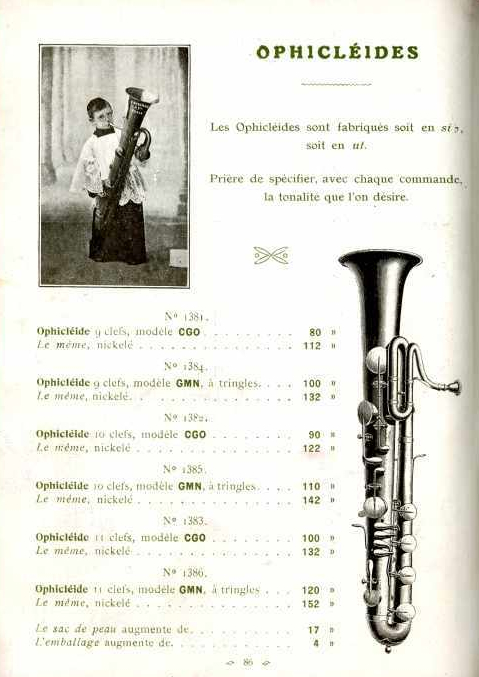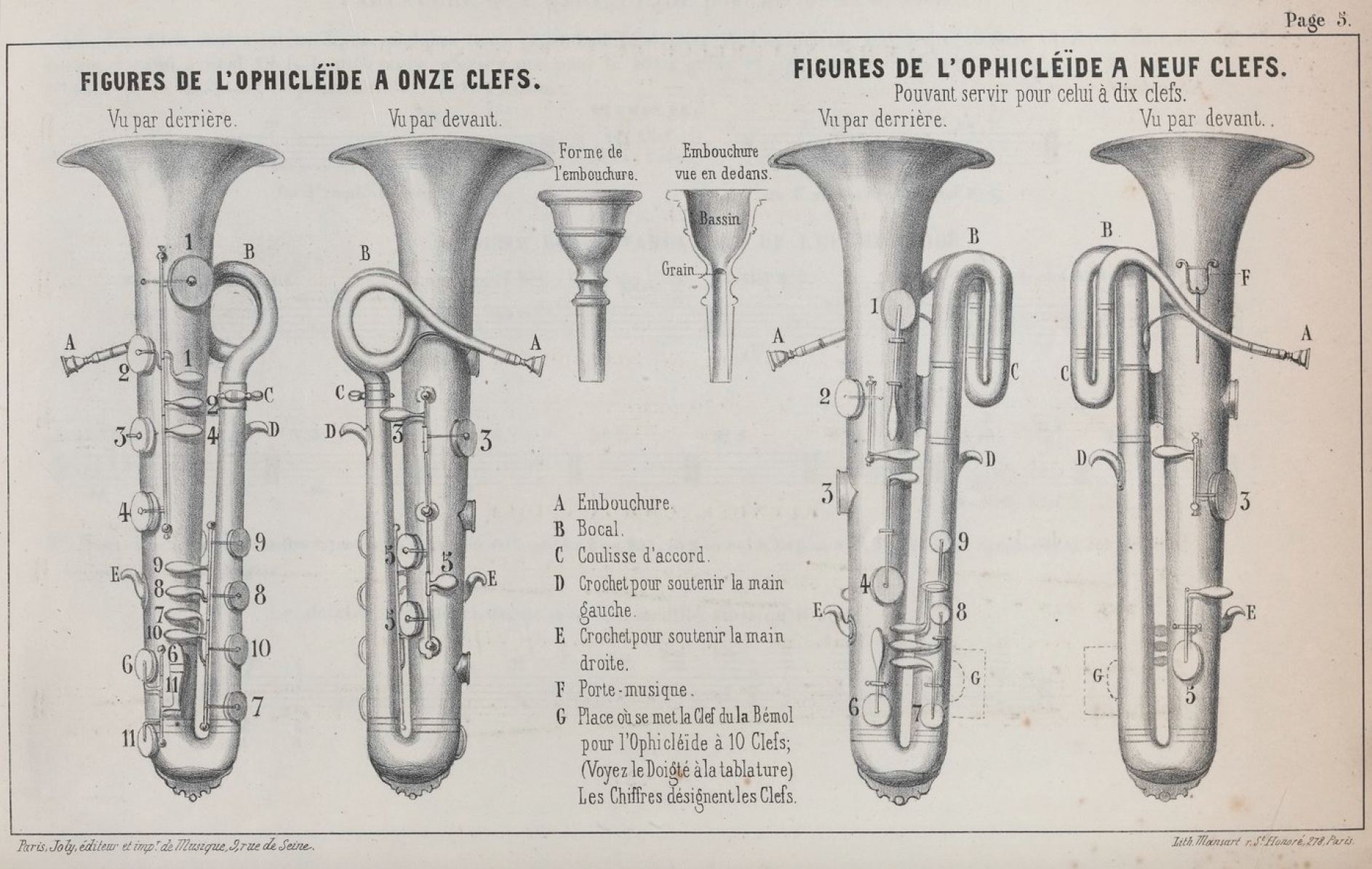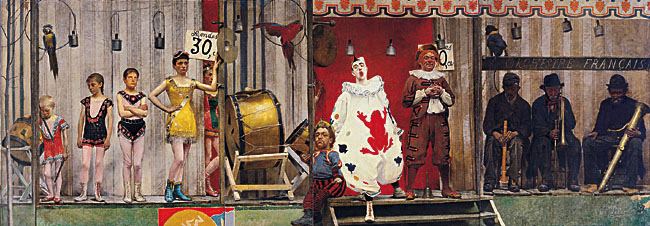1851—An illustration of a British infantry band by Ebsworth includes both a serpent and an ophicleide (see below image; public domain).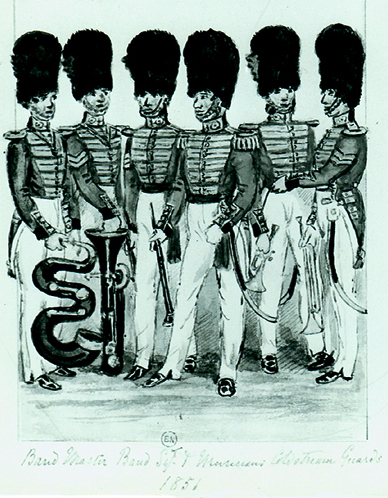
1853—Spain: A color lithograph depicting 3 soldiers in military uniform includes an ophicleide (see below image; public domain; New York Public Library Digital Collection).
1853—London, England: H.G. Hine’s The Waits at Seven Dials portrays a group of “Christmas waits” or street musicians, including what may be an ophicleide. After the Municipal Corporations Act of 1835, there were no more official waits as funded by British municipalities, but ad hoc musicians would often form at Christmas time in hopes of raising money (see below image; public domain) (Illustrated London News, December 1853). 1854—France: A watercolor by Lhéritier titled L’amour dans un ophicléide depicts a man in military garb playing ophicleide (see below image; public domain).
1854—France: A watercolor by Lhéritier titled L’amour dans un ophicléide depicts a man in military garb playing ophicleide (see below image; public domain).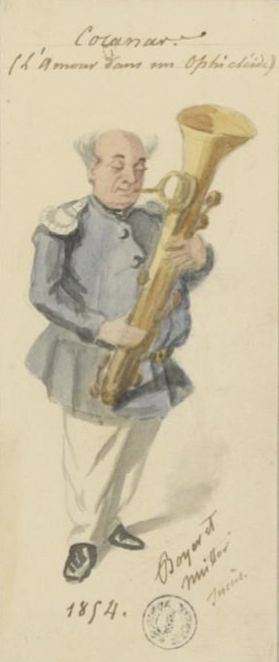
1855—Paris, France: Henri C. de Ploosen’s ophicleide method book, Nouvelle méthode d’ophicléide, is published. In addition to the image on the cover, a separate page features images diagramming the ophicleide and mouthpiece (see below images; public domain) (Ploosen cover and 5).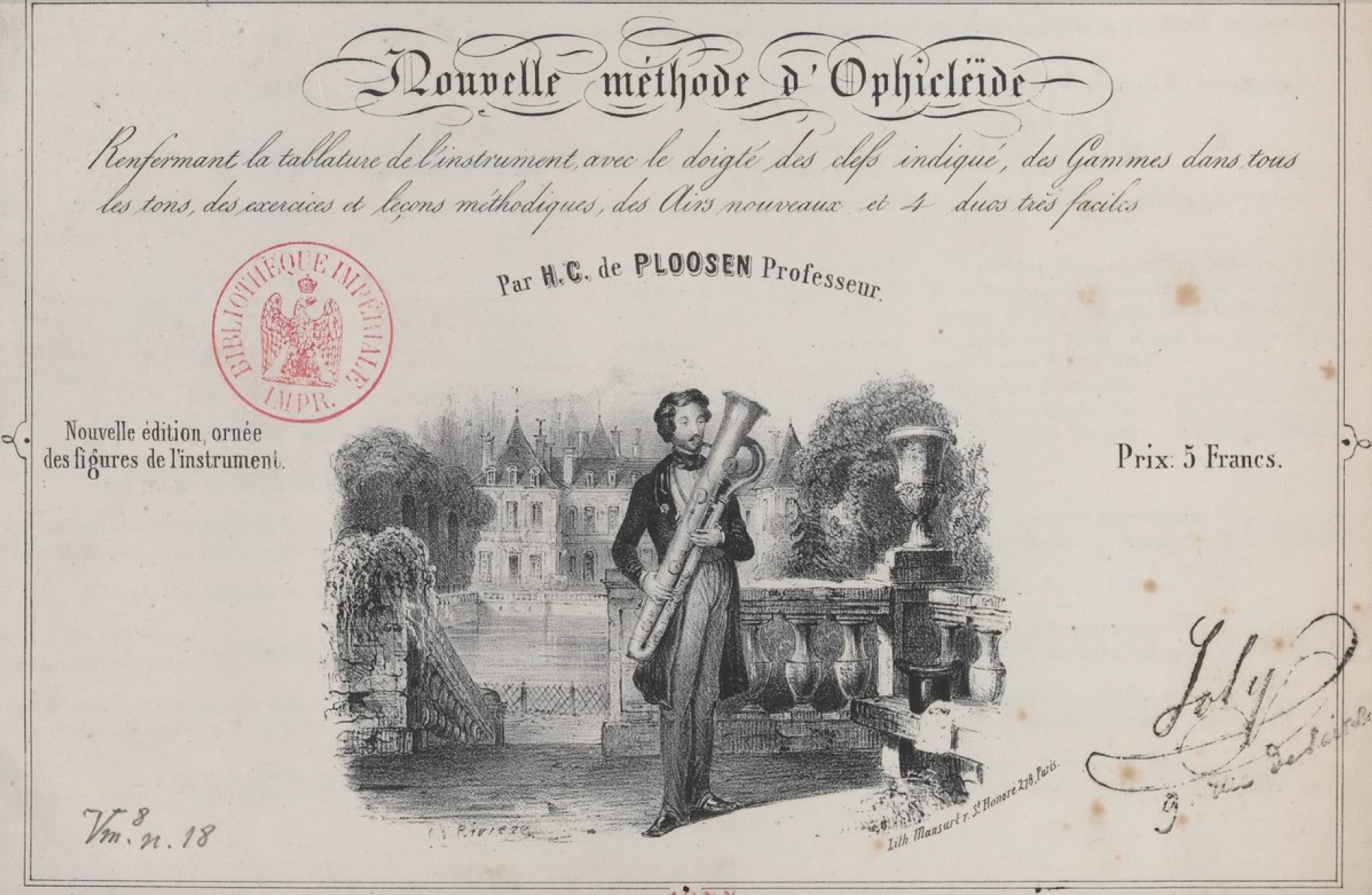
1855—New York: An illustration by Theodore Benecke titled Sleighing in New York includes a portrayal of a band performing from the balcony of Barnum’s Museum. One of the instruments appears to be an ophicleide (see below detail; public domain) (New York Public Library, Eno Collection of City Views; Bowles, Timpani 295).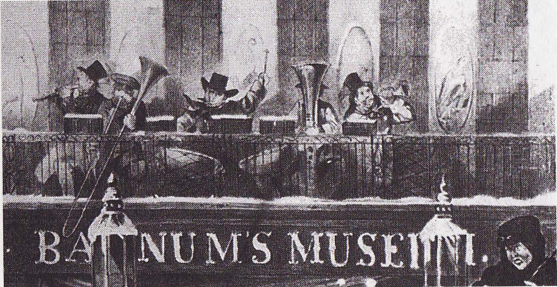
1857—Paris, France: Godefroy Durand’s Fête du pont du Gard: L’orchestre features a dance band that includes ophicleide (see below image; public domain) (L’Illustration, June 6, 1857, p. 356).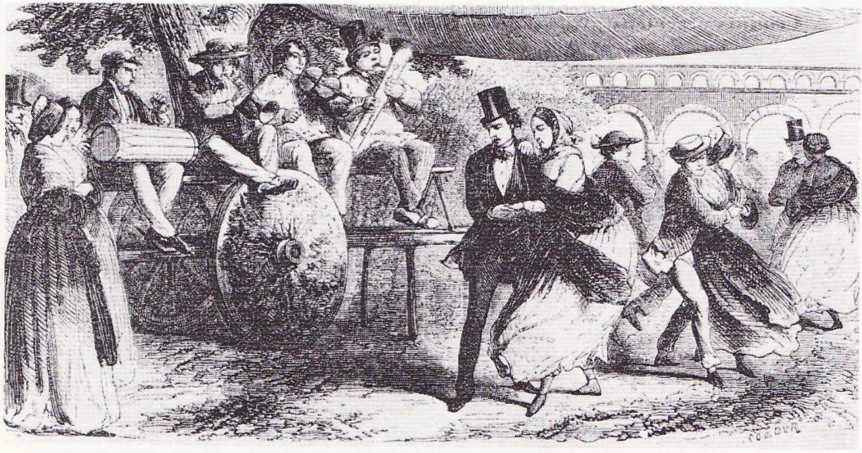
1857—Paris, France: The periodical L’Illustration prints a depiction of a military theatre with an orchestra that includes ophicleide (see below image; public domain) (September 5, 1857, p. 159).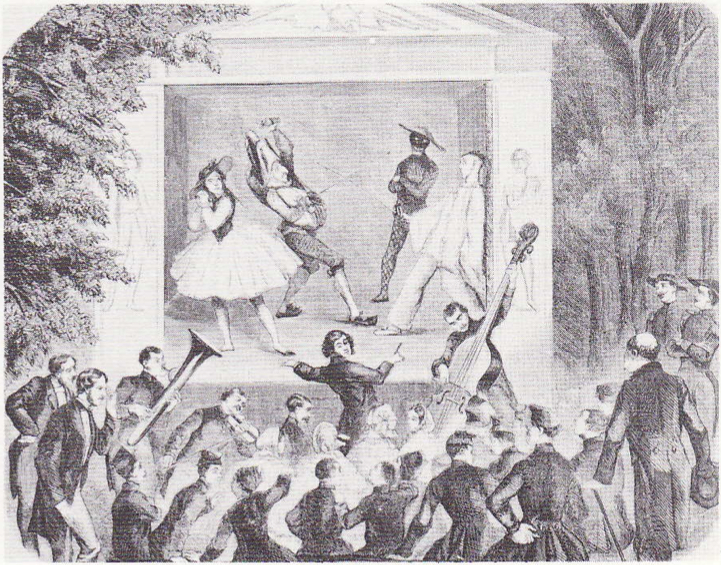
1858—London, England: An illustration of the band of the French National Guard published in London’s Illustrated Times includes what appears to be an ophicleide (see below image; public domain). 1858-1875—France: An engraving by Guillaumot of a serpent appears in the French dictionary, Dictionnaire raisonné du mobilier français de l’époque carlovingienne à la Rénaissance (see below image; public domain).
1858-1875—France: An engraving by Guillaumot of a serpent appears in the French dictionary, Dictionnaire raisonné du mobilier français de l’époque carlovingienne à la Rénaissance (see below image; public domain). c. 1860—Peru: Artist Pancho Fierro depicts what appears to be an ophicleide as part of a wind band performing for a Peruvian wedding celebration in Fiesta de Matrimonio (see below detail and full image below; public domain) (Lavalle 38).
c. 1860—Peru: Artist Pancho Fierro depicts what appears to be an ophicleide as part of a wind band performing for a Peruvian wedding celebration in Fiesta de Matrimonio (see below detail and full image below; public domain) (Lavalle 38).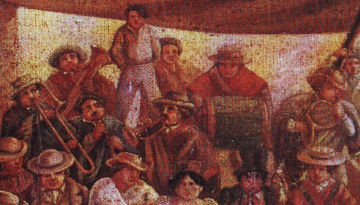
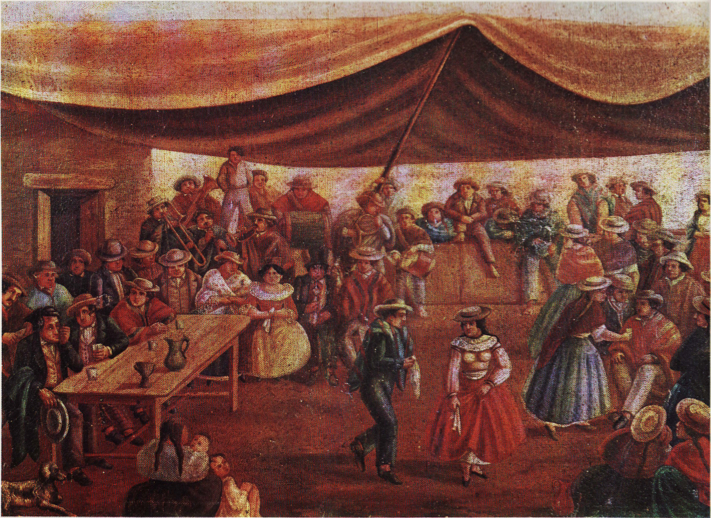 1860—England: An early photograph of the famous Besses o’ th’ Barn band includes ophicleide among an ensemble of primarily brass instruments (see below image; public domain) (Baines, Brass pl. XIV).
1860—England: An early photograph of the famous Besses o’ th’ Barn band includes ophicleide among an ensemble of primarily brass instruments (see below image; public domain) (Baines, Brass pl. XIV). 1860—Paris, France: La femme, faible créature, a print by Carlo Gripp, is published in L’Illustration (February 4, 1860, p. 77) (see below image; public domain).
1860—Paris, France: La femme, faible créature, a print by Carlo Gripp, is published in L’Illustration (February 4, 1860, p. 77) (see below image; public domain).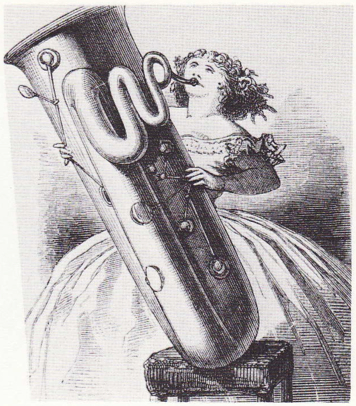 1860-1872—France: A color lithograph entitled Procession de Ste Anne d’Auray includes an ophicleide as part of the procession (see below image; public domain) (Paris, Museum of European and Mediterranean Civilization). For a similar image, see 1847, above.
1860-1872—France: A color lithograph entitled Procession de Ste Anne d’Auray includes an ophicleide as part of the procession (see below image; public domain) (Paris, Museum of European and Mediterranean Civilization). For a similar image, see 1847, above.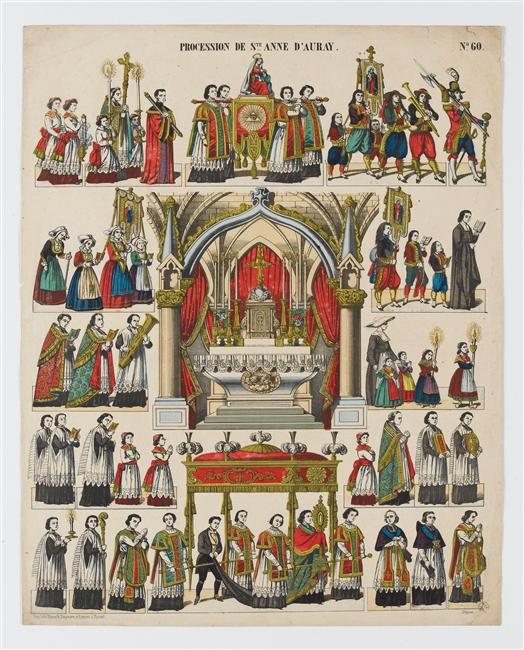 1861—Paris, France: A print after a sketch by Rogier, published in the periodical L’Illustration, depicts the entry and reception of European Commissioners in Damascus. Among the musicians is a pair of ophicleides and a rear-facing trombone (see below image; public domain) (February 23, 1861, p. 119).
1861—Paris, France: A print after a sketch by Rogier, published in the periodical L’Illustration, depicts the entry and reception of European Commissioners in Damascus. Among the musicians is a pair of ophicleides and a rear-facing trombone (see below image; public domain) (February 23, 1861, p. 119). 1862—France: Consequence of the Tax on Pianos, a print by satirist Amédée-Charles-Henri de Noe, aka Cham, is printed in Journal pour rire (see below image; public domain) (Fromrich 150).
1862—France: Consequence of the Tax on Pianos, a print by satirist Amédée-Charles-Henri de Noe, aka Cham, is printed in Journal pour rire (see below image; public domain) (Fromrich 150). 1862—Paris, France: Artist Janet Lange depicts an ophicleide player from the Mexican army in a print published in L’Illustration and titled Armée mexicaine—Musicien (see below image; public domain) (April 5, 1862, p. 214).
1862—Paris, France: Artist Janet Lange depicts an ophicleide player from the Mexican army in a print published in L’Illustration and titled Armée mexicaine—Musicien (see below image; public domain) (April 5, 1862, p. 214).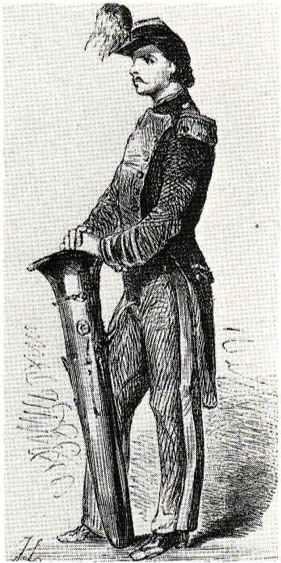
1862—Paris, France: A print by Jules Gaildrau entitled Fête des mécaniciens de la marine Impériale is published in the periodical L’Illustration. It includes an ophicleide among the band instruments at the celebration (see detail and full image below, after a sketch by Letuaire; public domain) (Dec 27, 1862, p. 432).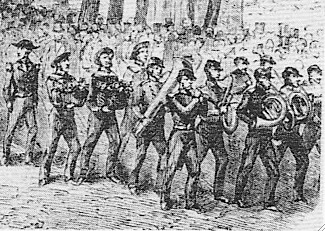
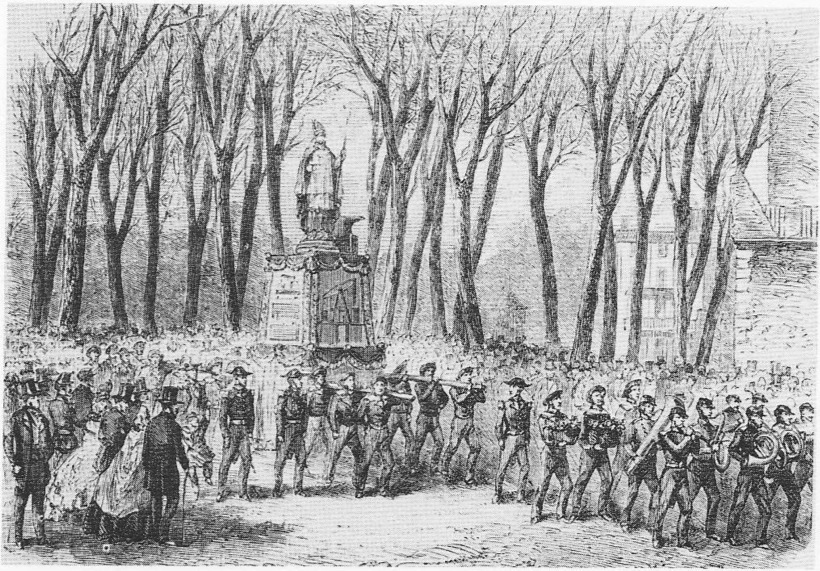
1862-71—Paris, France: A caricature by Draner (Jules Renard) from his collection, Types Militaires, reflects the two traditional homes of the serpent: church and military (see below image; public domain).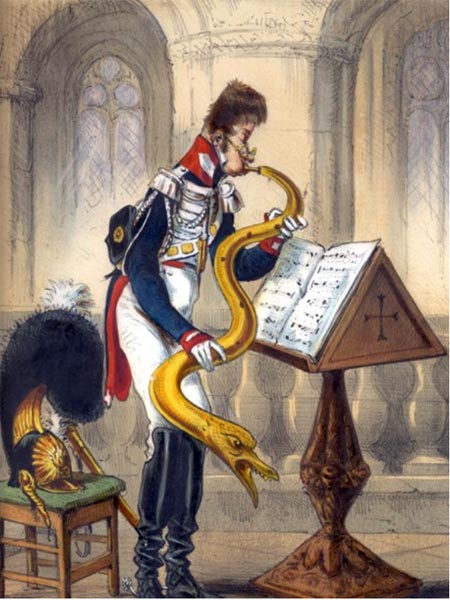
1863—Rome, Italy: Concerto di Frascati, a watercolor depicting military musicians in the town of Frascati, part of metropolitan Rome, features trombone and ophicleide (see below image; public domain) (Italian Digital Library; Istituto per la storia del Risorgimento italiano).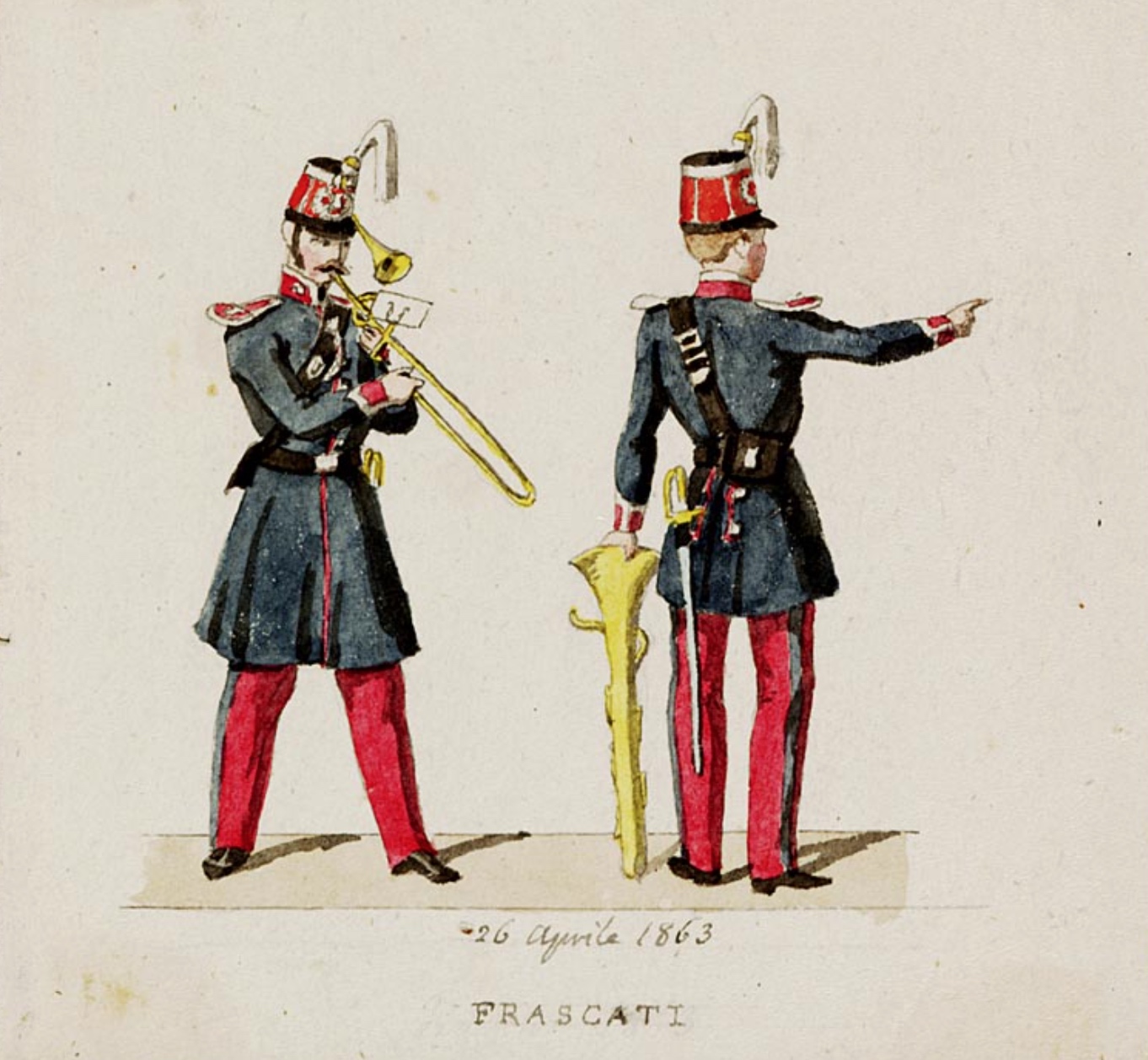
1865—Paris, France: A satirical graphic titled Domestic joys of parents whose daughters take part in women’s orchestras, published in Le monde illustré, includes a woman playing what appears to be an ophicleide (see below image; public domain) (Le monde illustré, 9, no. 442; Sept 30 1865).
1865—A satirical cartoon titled “The serpent starting to tempt the woman once again,” printed in Le monde illustré, features a woman playing a dragon-belled serpent (see below image; public domain) (Le monde illustré, 9, no. 442; Sept 30 1865).
1865—Paris, France: The caption for a cartoon showing a man with an ophicleide over his head explains, curiously, that the musician uses his instrument to cure his migraine (see below image; public domain) (L’Illustration, April 8, 1865, p. 221).
1865—Paris, France: The illustrated newspaper L’Illustration publishes a print depicting the Theatre imperial de l’Opera-Comique. What appears to be a man playing a serpent can be seen in the bottom-left corner of the picture (see below image; public domain) (December 23, 1865, p. 405).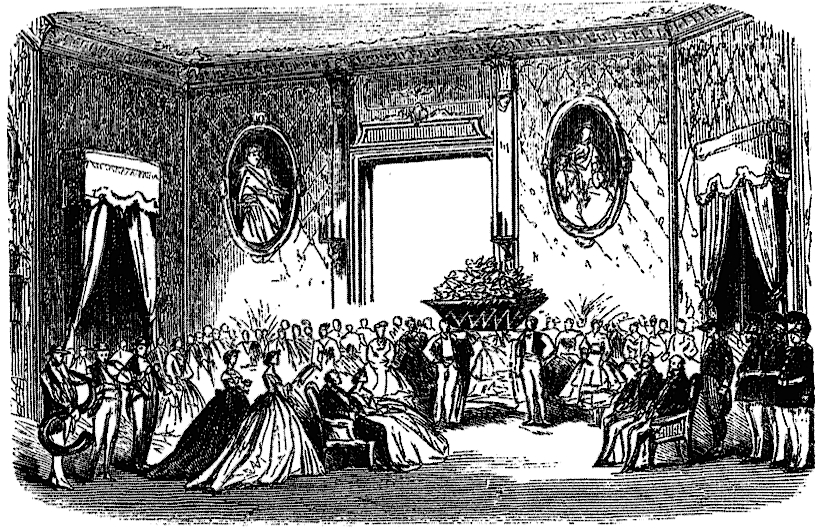
1865-1916—Netherlands: A painting by artist Willem Constantijn Staring (1847-1916) depicts bandsmen of the 9th Regiment Infantry, including a musician playing a green-colored serpent (see below image; public domain).
1867—Paris, France: A print after a drawing by Letuaire depicts the funeral convoy of Commander John Cornwall, US Navy, who died aboard the Miantonomah in Toulon Harbor. Among the musicians in the procession are two ophicleides (see detail and full image below; public domain) (L’Illustration, March 2, 1867, p. 140).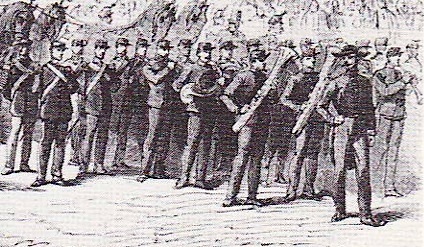

1870—Turnov, Czech Republic: An engraving after a drawing by A. J. Levy (1845-1897) portrays what appears to be an ophicleide playing with a brass band in the public square in Turnov (see detail below; public domain) (Volek plate 347).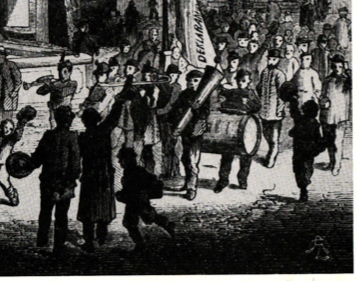 1871—Milan, Italy: Giuseppe Verdi makes the following comment about bass trombone in a letter to his publisher about the forthcoming Italian premiere of Aida: “I must insist on the fourth trombone. That bombardon is impossible. Tell Faccio [the conductor] to consult the first trombonist if he thinks fit, to see what should be done. I should prefer a bass trombone, which is of the same family as the others: but if it proves too tiring and difficult to play, take one of the usual ophicleides which go down to low B. In short, do whatever you please, but not that devil of a bombardon which does not blend with the others” (Leavis, Cimbasso).
1871—Milan, Italy: Giuseppe Verdi makes the following comment about bass trombone in a letter to his publisher about the forthcoming Italian premiere of Aida: “I must insist on the fourth trombone. That bombardon is impossible. Tell Faccio [the conductor] to consult the first trombonist if he thinks fit, to see what should be done. I should prefer a bass trombone, which is of the same family as the others: but if it proves too tiring and difficult to play, take one of the usual ophicleides which go down to low B. In short, do whatever you please, but not that devil of a bombardon which does not blend with the others” (Leavis, Cimbasso).
1871—Germany: Musical Emancipation, a German woodcut, shows a woman in an ophicleide lesson (see below image; public domain).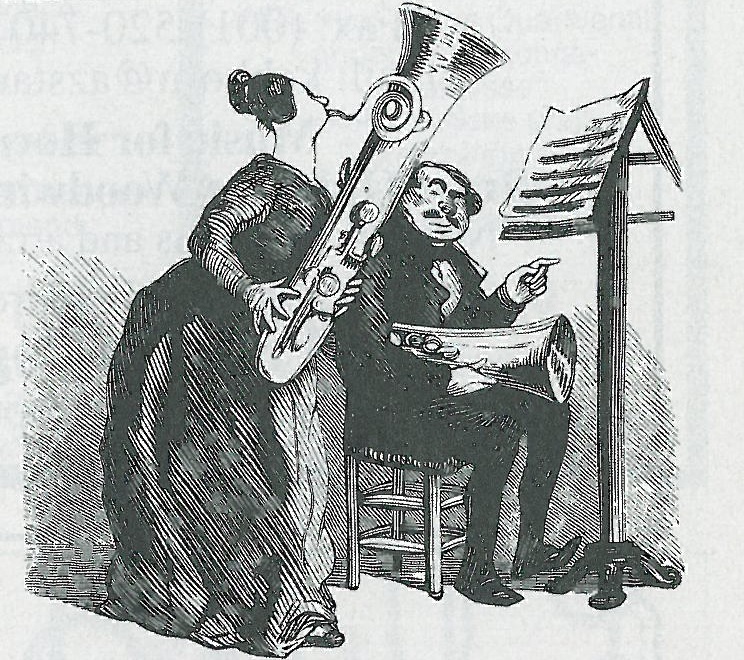
1872—Paris, France: A pair of humorous prints by Bertall titled Plus d’obéissance passive (more passive obedience) are published in the periodical L’Illustration. One of the images features an ophicleide player with a conductor (see below image; public domain) (June 29, 1872, p. 415).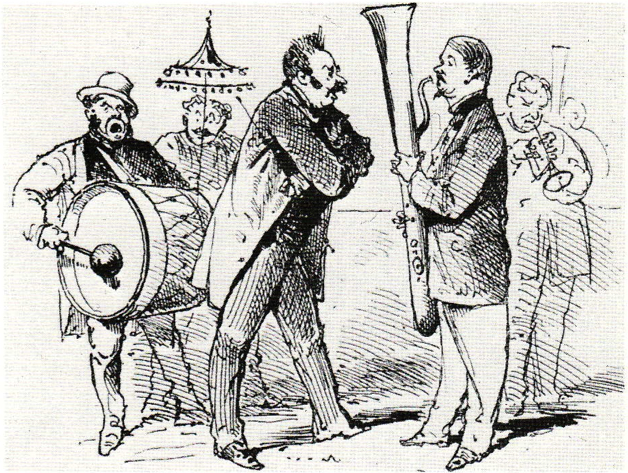 1872—London, England: A humorous depiction of an ensemble titled German Band is published in The Graphic, an illustrated weekly newspaper (see below image; public domain).
1872—London, England: A humorous depiction of an ensemble titled German Band is published in The Graphic, an illustrated weekly newspaper (see below image; public domain).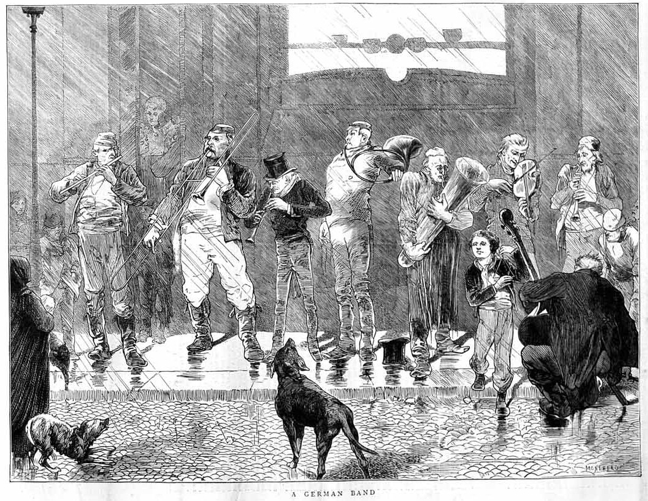
c. 1873—A caricature of a bandsman playing ophicleide by Major T. S. Seecombe is featured as part of a collection called Army and Navy Drolleries (see below image; public domain).
1874—Paris, France: A print by Bertall titled A serenade to M. de Lorgeril depicts a musical ensemble that includes what appears to be an ophicleide (see below image; public domain) (L’Illusration, February 28, 1874, p. 140).
1874—London, England: Punch, the British magazine of humor and satire, includes an image of an angel playing ophicleide (see below image; public domain).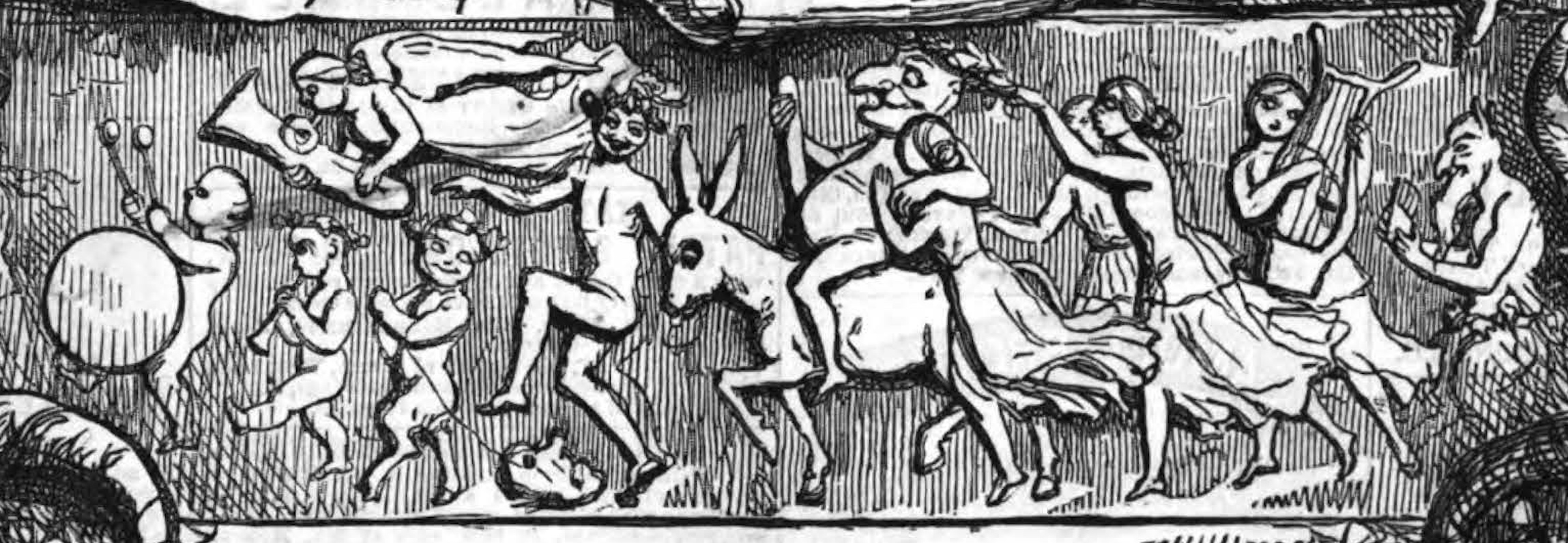
c. 1875—Paris, France: Choeur de six personnages en costume ecclésiastique devant un lutrin, a pen and ink drawing by French painter and illustrator Charles Henri Pille, features an ophicleide player accompanying 5 singers, all of them in religious garb (see below image; public domain) (Paris, The Louvre).
c. 1875—London, England: A set of caricatures by Major Thomas Strong Seccombe for a children’s alphabet book called Army and Navy Drolleries includes a lithograph of a bandsman playing ophicleide (see below image; public domain).
1875-1900—Epinal, France: An image published by Pellerin, entitled French Music (Dragoons), depicts a group of military musicians on horseback, including two playing ophicleide (see bottom row, below; public domain) (Museum of European and Mediterranean Civilization).
1875—Paris, France: An image of an ophicleide player getting rained on, titled The excursion to Lake Como thwarted by bad weather: A musician of the corporation Como, is published in the illustrated periodical, L’Illustration (see below image; public domain) (October 30, 1875, p. 274).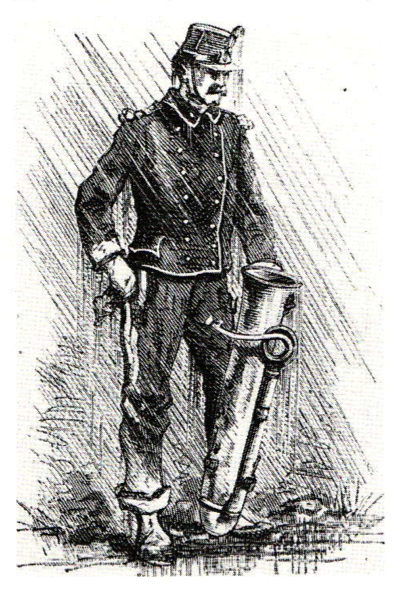
1876—Paris, France: Pépin’s, Musica de chambres, a political print published in Le Grelot (no. 278, August 6, 1876), depicts duelling ophicleides (see below image; public domain).
1876—Paris, France: Université illustrée publishes Chantres au lutrin, a print by Henri Brispot depicting a serpent with voices (see below image; public domain) (October 1876; source: Museum of Musical Instruments).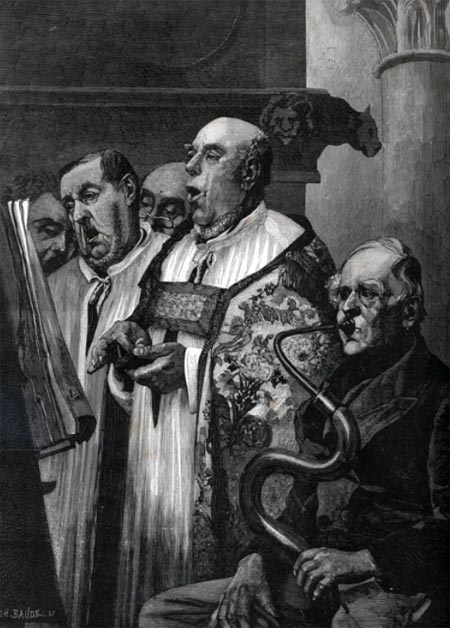
1879—Paris, France: A print of M. Denneulin’s Un Passage difficile is published in the illustrated periodical, L’Illustration (see below image; public domain) (March 8, 1879, p. 147).
c. 1880—France: An oil painting very similar to several other images (e.g. 1879, above) shows a canon playing ophicleide (see below image; public domain) (source: Renard Music).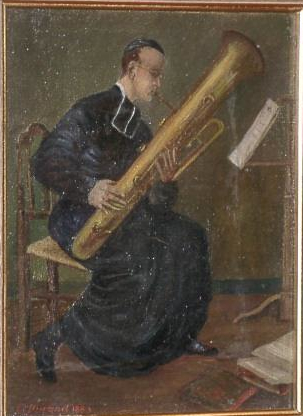
1883—Paris, France: L’Illustration publishes a caricature, titled Concours du Conservatoire, of an ophicleide player apparently impressing the judges at the conservatoire’s annual competition (see below image; public domain) (July 28, 1883, p. 61).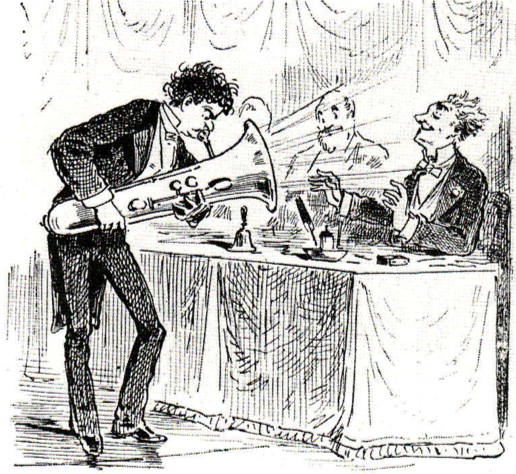
1883—United Kingdom: Macmillan publishes the third volume of the first edition of Grove’s Dictionary of Music and Musicians, which contains the below image of a serpent (see below; public domain).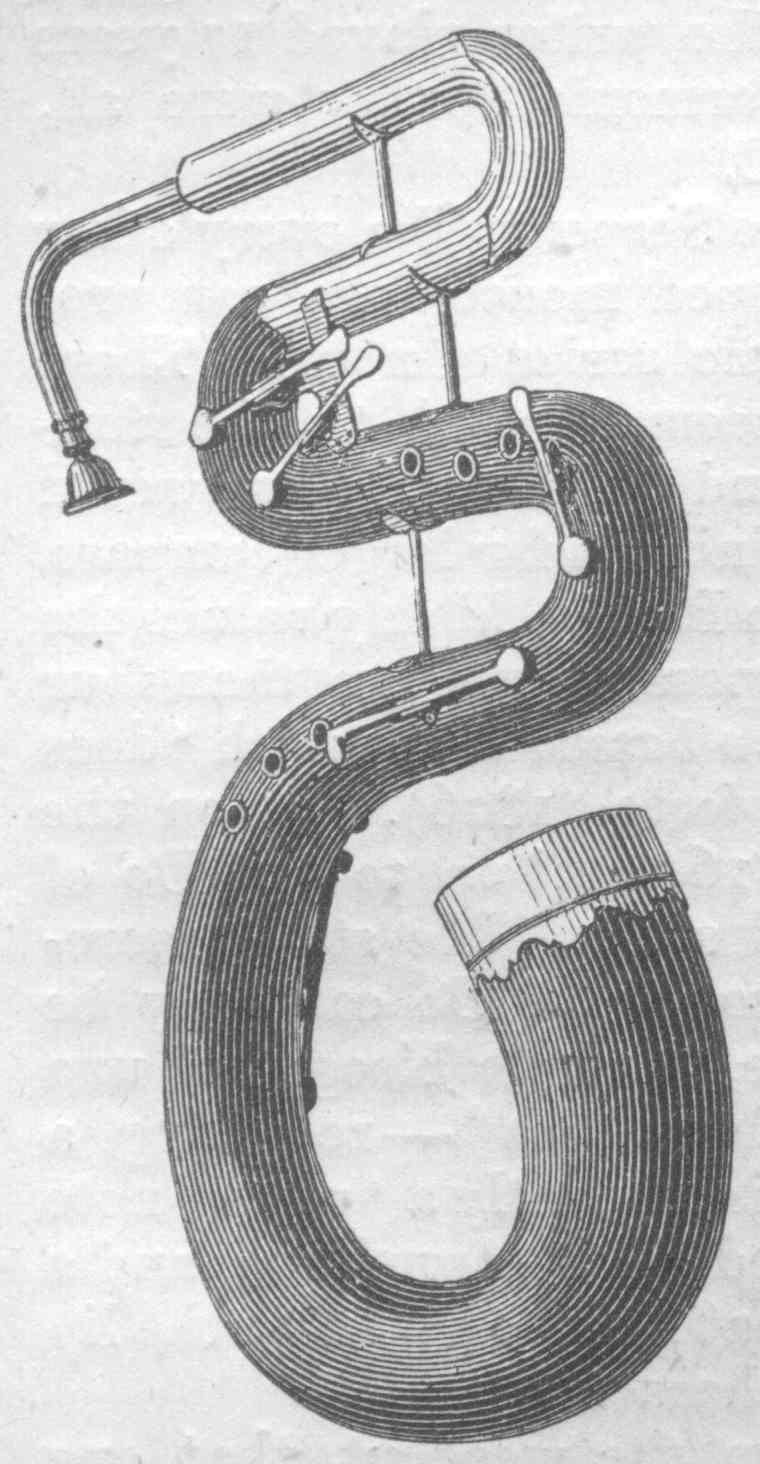
1883—France: Charles Gilbert-Martin’s L’homme Orchestra, asatirical political image published in the Don Quichotte magazine in July 1883, depicts a one man band that includes an ophicleide(see below image; public domain).
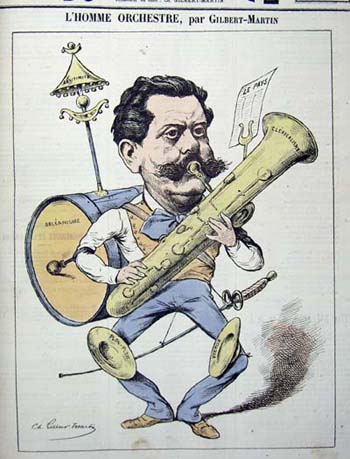 1886—Paris, France: The illustrated newspaper, L’Illustration, publishes a drawing of conservatory museum holdings, titled Le musée du conservatoire—Instruments a vent, that includes serpents (see below image; public domain) (July 24, 1886, p. 50).
1886—Paris, France: The illustrated newspaper, L’Illustration, publishes a drawing of conservatory museum holdings, titled Le musée du conservatoire—Instruments a vent, that includes serpents (see below image; public domain) (July 24, 1886, p. 50). 1887—France: Artist François Thévenot’s watercolor, La chorale de l’église de Vaucotte en 1887, depicts a choral rehearsal at the church of Vattetot-sur-Mer in which the music director holds an ophicleide (see below image; public domain).
1887—France: Artist François Thévenot’s watercolor, La chorale de l’église de Vaucotte en 1887, depicts a choral rehearsal at the church of Vattetot-sur-Mer in which the music director holds an ophicleide (see below image; public domain).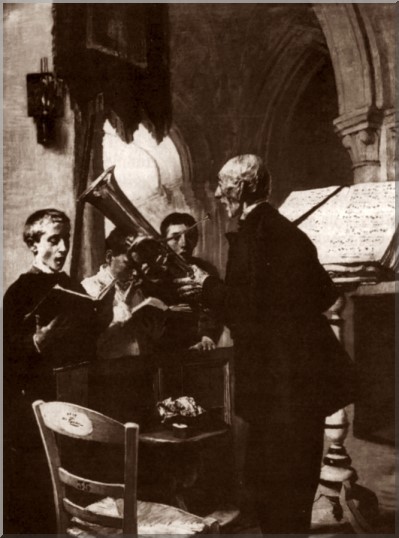 1887—France: A painting by Edmond de Boislecomte entitled The Lectern of Aulnay-les-Bondy features an ophicleide player in a sacred setting (see below image; public domain).
1887—France: A painting by Edmond de Boislecomte entitled The Lectern of Aulnay-les-Bondy features an ophicleide player in a sacred setting (see below image; public domain). 1888—Paris, France: François Sudre offers ophicleides in his catalogue (see below image; public domain) (Sudre, July 1888, p. 4).
1888—Paris, France: François Sudre offers ophicleides in his catalogue (see below image; public domain) (Sudre, July 1888, p. 4). 1888—Paris, France: Fernand Pelez’s Grimaces and Misery depicts poor circus workers situated on a platform, including a group of three seated musicians (see below detail and full image beneath; public domain) (Musée du Petit Palais, Paris).
1888—Paris, France: Fernand Pelez’s Grimaces and Misery depicts poor circus workers situated on a platform, including a group of three seated musicians (see below detail and full image beneath; public domain) (Musée du Petit Palais, Paris).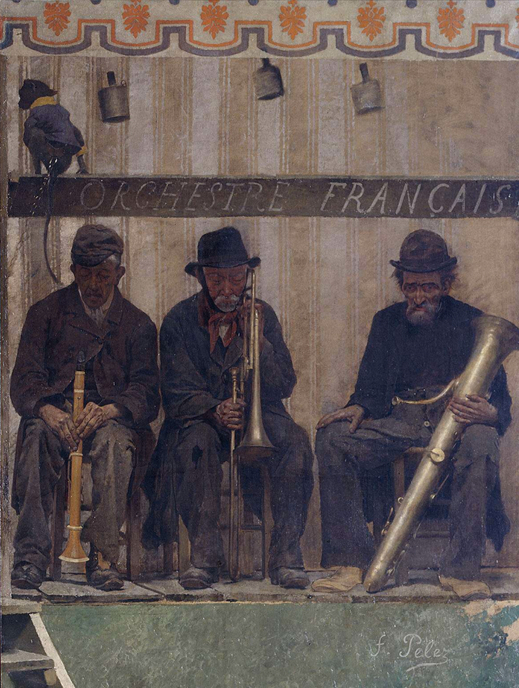
1889—London, England: Author George Bernard Shaw, in his music criticism column, comments on his family exposure to trombone: “I believe that a taste for brass instruments is hereditary. My father destroyed domestic peace by immoderate indulgence in the trombone; my uncle played the ophicleide—very nicely, I must admit—for years, and then perished by his own hand. Some day I shall buy a trombone myself.”
1893—Markneukirchen, Germany: A catalog for instrument manufacturer Paul Stark offers an ophicleide with several options (see middle of below image; public domain) (source: The Bassic Sax Blog).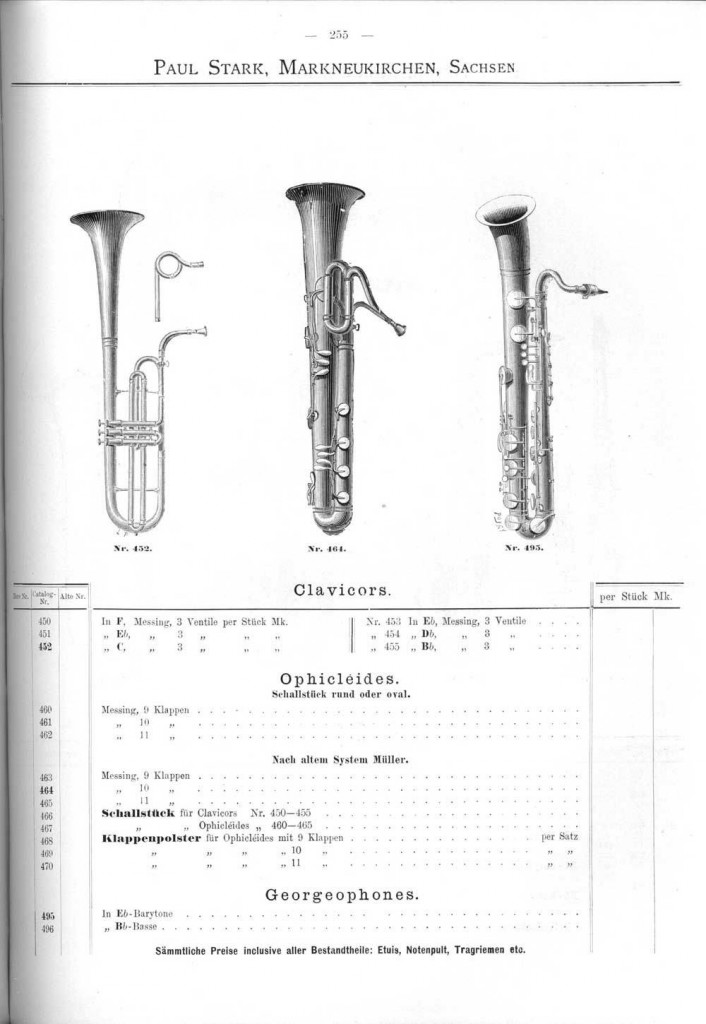
1894—Paris, France: A print by Henriot depicting a Salvation Army band in Paris’s Latin quarter includes what appears to be an ophicleide (see below image; public domain) (L’Illustration, February 10, 1894). c. 1895—Rome, Italy: Spanish painter José Gallegos y Arnosa (1857-1917) depicts the ophicleide as a member of a small sacred ensemble accompanying a young boy’s chorus in two paintings, Choir Practice and Chorus (see below images; public domain). For a print based on these paintings, see here.
c. 1895—Rome, Italy: Spanish painter José Gallegos y Arnosa (1857-1917) depicts the ophicleide as a member of a small sacred ensemble accompanying a young boy’s chorus in two paintings, Choir Practice and Chorus (see below images; public domain). For a print based on these paintings, see here.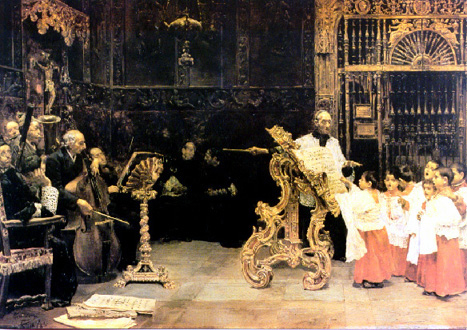
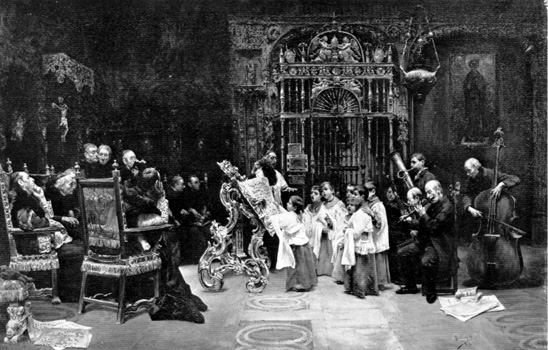
1895—Paris, France: Henriot’s comic, printed in L’Illustration, depicts a man in the cold conversing with an ophicleide player. The ophicleide player proclaims that he manages to stay warm by filling his horn with hot water (see below image; public domain) (March 16, 1895).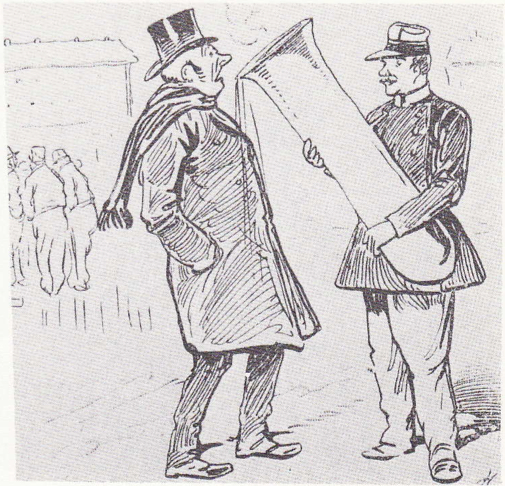
1895—Paris, France: An illustration of a concert of European toy soldiers for a music box by Henriot includes what appear to be multiple ophicleides (see below image; public domain) (L’Illustration, December 21, 1895, p. 4).
1897—Paris, France: The Soldier-Singers, a cartoon by Henriot, includes an ophicleide. The caption explains, “They add some canteen-singers to lend the regiment more gusto” (L’Illustration, June 26, 1897, p. 8) (see below image; public domain).
1897—Paris, France: Pépin’s La musique adoucit, etc…, a satirical political print, depicts two conjoined ophicleides (Le Grelot, no. 1389, Nov. 21, 1897) (see below image; public domain).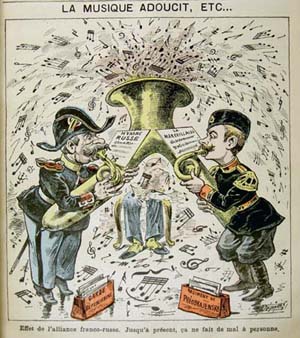
1897—Paris, France: An illustration for the cover of Figaro Illustré by H. Kaemmerer includes an ophicleide playing on stage at a Paris fair (see far left of below image; public domain) (Figaro Illustré 92, Nov. 1897).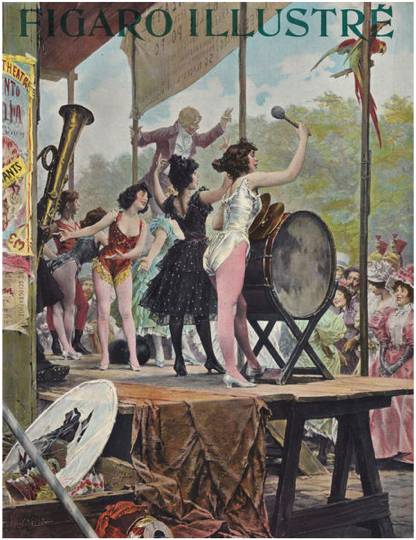
1897—Paris, France: A comic by Henriot (pseudonym for cartoonist Maigrot Henry) features an ophicleide being used to hold champagne by soldiers of the Préobrajensky regiment, a prestigious regiment of the Russian Imperial Guard. The caption reads, “La musique du régiment de Préobrajensky.—Encore des patriotes qui ont fourré dans ton ophicléide six bouteilles de champagne!—Je comprends maintenant pour quoi il ne voulait pas jouer!” (see below image; public domain) (L’Illustration, Nov 20, 1897).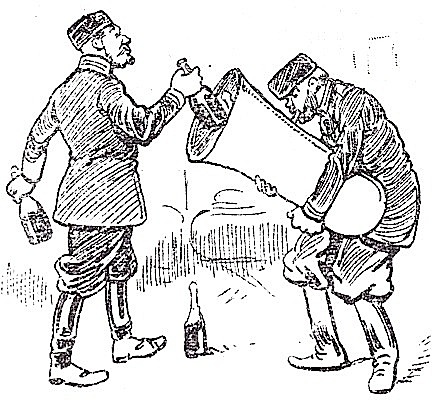
1898—Paris, France: A photograph published in L’Illustration includes a man holding an ophicleide. The caption reads “Brocanteurs emportant leur butin,” or, loosely translated, “Junk dealers taking their loot” (see below image; public domain) (March 12, 1898, p. 200).
1898—Paris: Children watching a French soldier play the cymbals, military band in background, originally printed in L’épopée du costume militaire français, includes a soldier holding a serpent (see below image, click to expand; public domain).
c. 1900—France: An image entitled Musique d’Infanterie by Maurice Orange (1867-1916), depicting military musicians of an earlier era (1806), includes a serpent and what is probably a buccin, or trombone with dragon-head bell (see below image; public domain).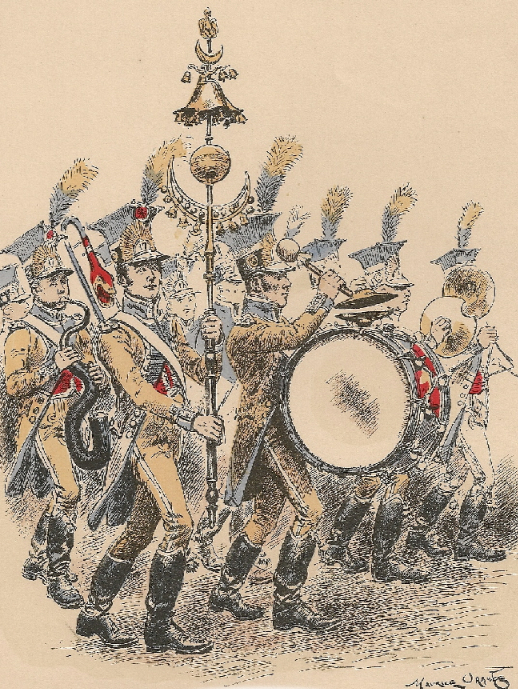 c. 1900—Philadelphia, PA (?): A painting by Jean Leon Gerome Ferris (1863-1930) entitled Liberty’s Pulpit includes a man holding an ophicleide. Use of an ophicleide in the painting could be a reflection of the artist’s training in France (see below image; public domain).
c. 1900—Philadelphia, PA (?): A painting by Jean Leon Gerome Ferris (1863-1930) entitled Liberty’s Pulpit includes a man holding an ophicleide. Use of an ophicleide in the painting could be a reflection of the artist’s training in France (see below image; public domain).
c. 1900—Cantaron, France: An advertisement features a young ophicleide player (see below image; public domain).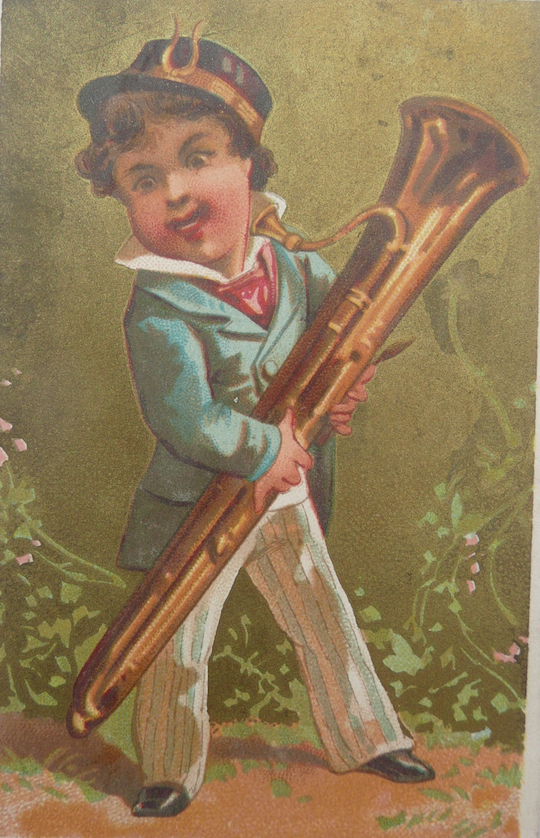
c. 1900—A French chocolate advertisement depicts a soldier playing ophicleide (see below image; public domain).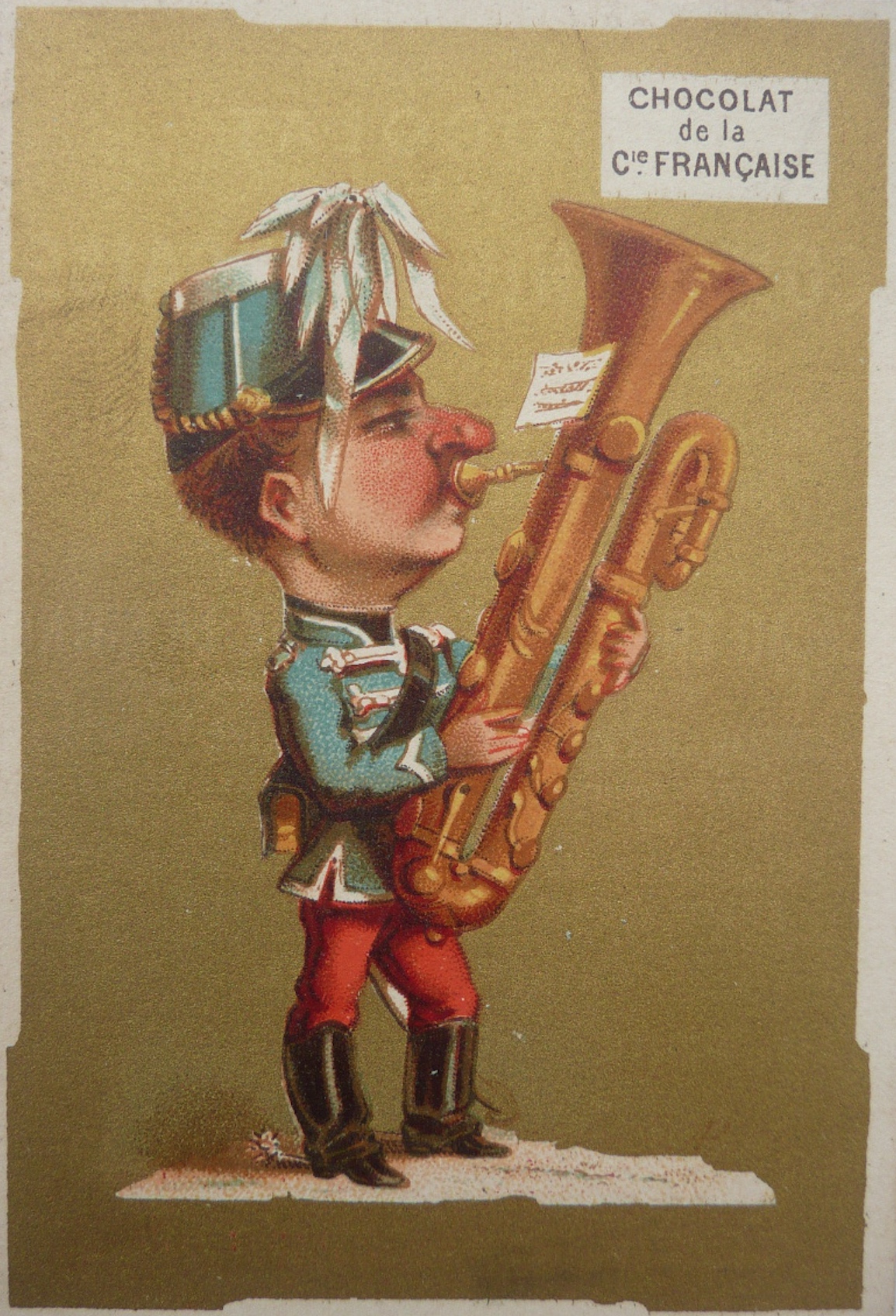
1900—Boston, MA: Louis Charles Elson includes a picture of a serpent in his discussion of musical instruments in Famous Composers and Their Works (see below image; public domain) (Elson Famous 140).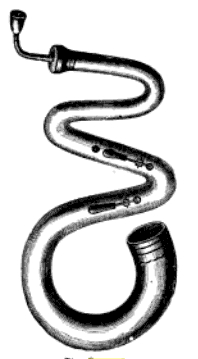
1903—Nancy, France: A postcard from a series published by A. Bergeret shows a caricature of two street buskers (see below image; public domain) (source: temposenzatempo.blogspot.com).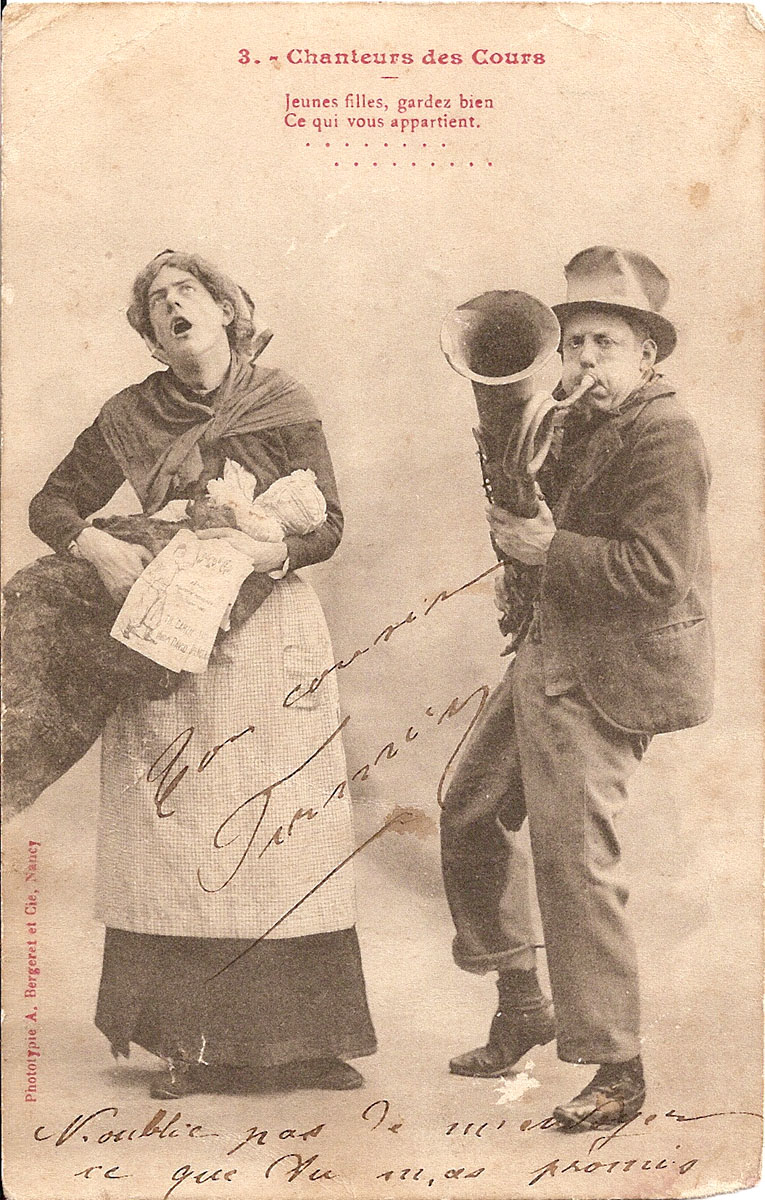
1906—A postcard by R. F. Outcault from Buster Brown Series No. 1000 depicts a young ophicleide player (see below image; public domain) (Serpent Newsletter, September 2011 [black and white version]).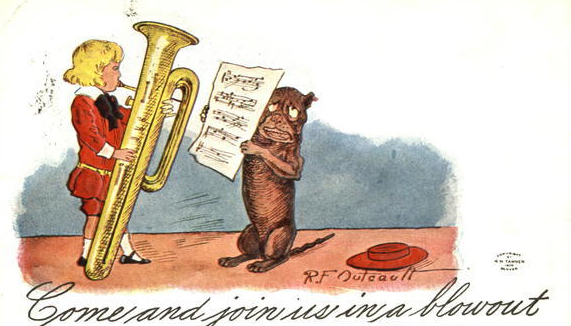
c. 1908—Cuba: Enrique Peña’s popular Cuban band, Orquesta típica, includes an ophicleide (figle) (see below image; public domain) (source: wikimedia commons).
1909—Normandie, France: A postcard from Normandie, France features a photograph of a serpent player, probably from a rural church in France, playing from what appears to be a book of plainchant (see image below; public domain) (source: temposenzatempo).
1909—An oil painting shown cantors playing bassoon and ophicleide is signed “Galla 1909” (see below image; public domain) (source: Renard Music).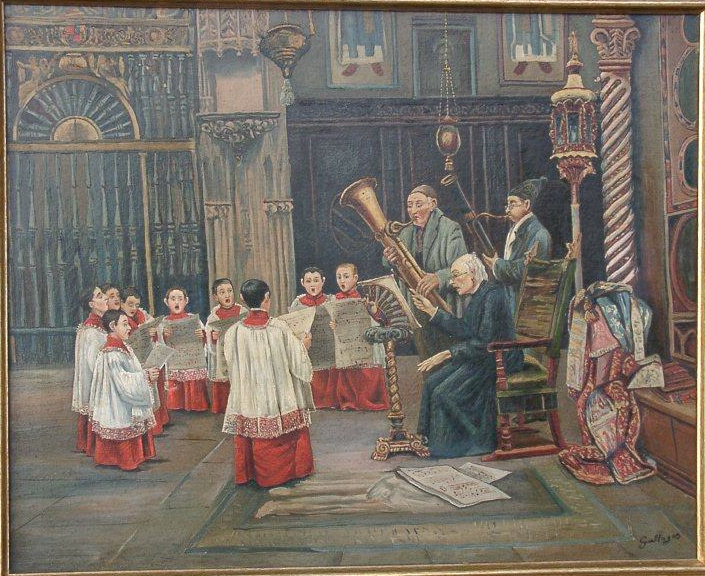
1909—Paris, France: A. Robida’s Le Patron Nicklaus, with illustrations by the author, includes an illustration of ophicleide participating in a serenade (see below image; public domain) (Robida 267).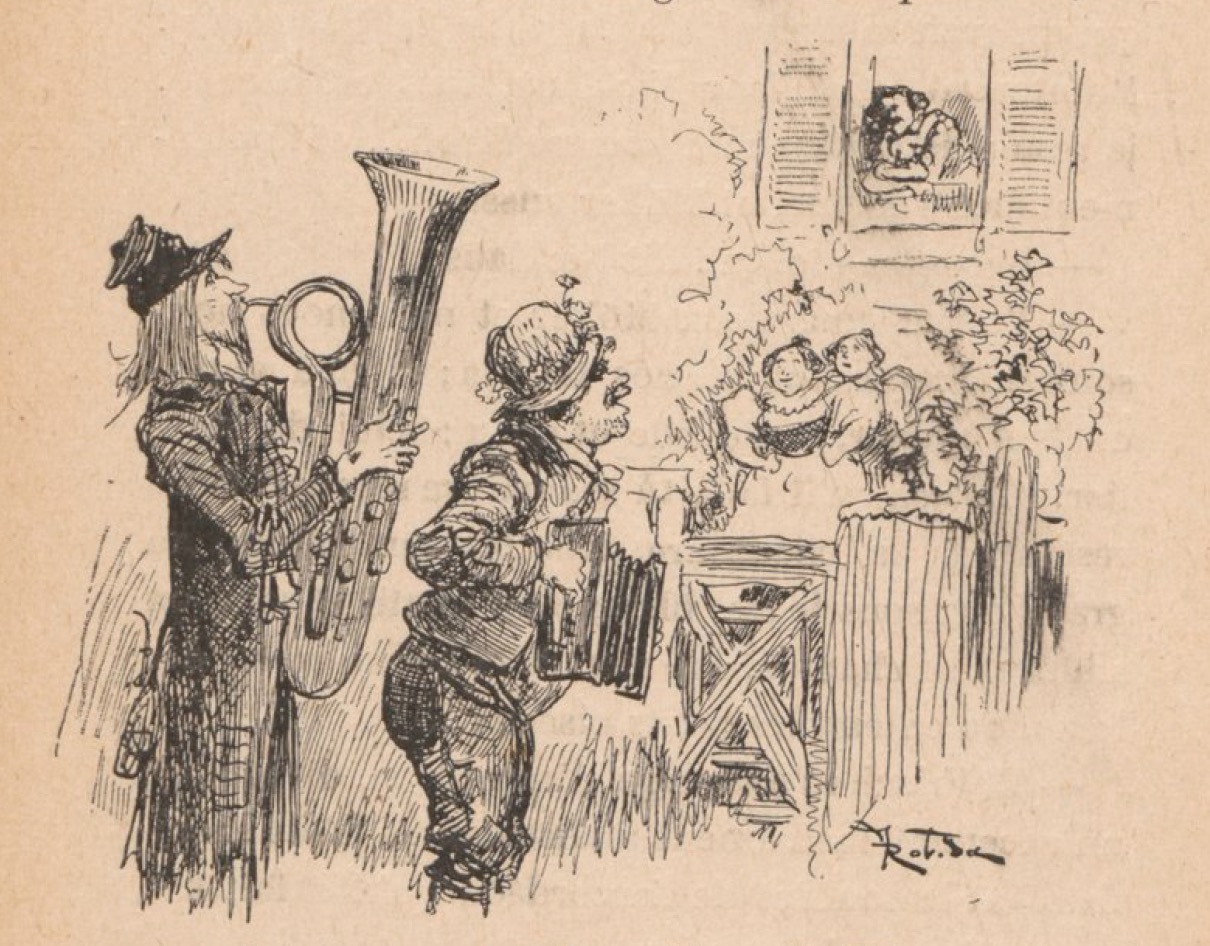
c. 1910—France: A postcard celebrating the French musical instrument company Couesnon features a young boy playing an ophicleide (see below image; public domain) (source: temposenzatempo). The same photograph is also found in the company’s 1912 catalogue (see 1912, below).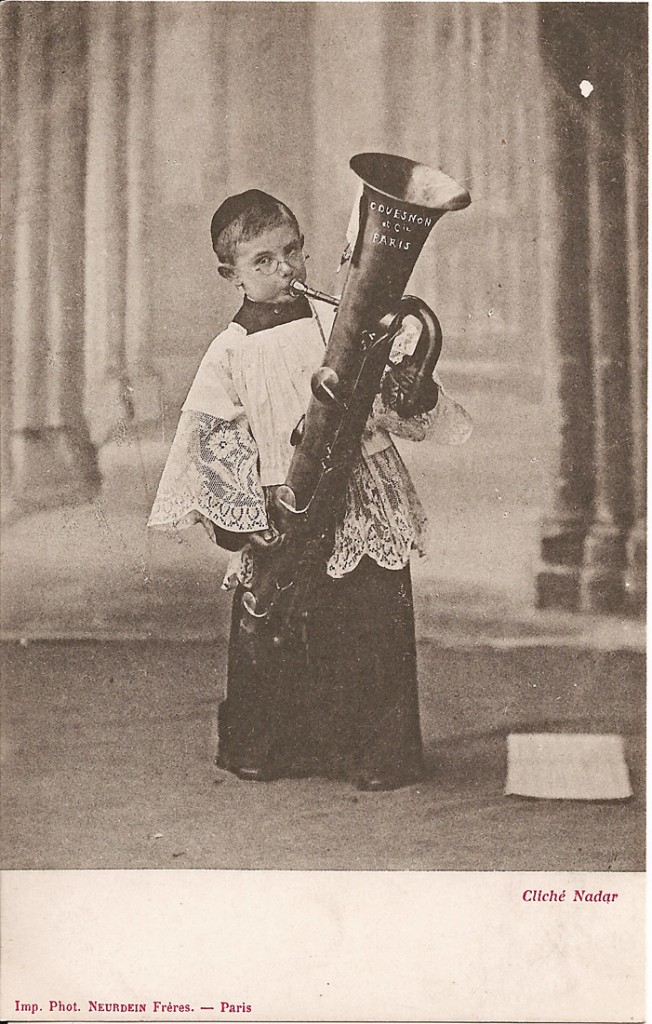
1910—England: The entry on ophicleide in the 1910 edition of Grove’s Dictionary of Music and Musicians includes the following statement: “Since the date of the first edition of this work the ophicleide has become obsolete.” Elsewhere in the article is the statement, “The tone of the ophicleide is, from its difference of scale and of material, less tender and veiled than that of its predecessor the serpent, but on the other hand it has greater compass and equality than that rather primitive contrivance.” The photograph included with the entry is shown below (see below image; public domain) (Grove’s, vol. 3, p. 473). 1912—Milan, Italy: In Ettore Panizza’s 2nd revised and updated Italian edition of Berlioz’s orchestration treatise, Panizza discusses contrabass trombone: “Berlioz does not mention the contrabass trombone. Its pitch corresponds to an octave below that of the tenor trombone. In Italy the introduction of a new instrument of this type was due to Giuseppe Verdi, and it adopted the name of this great musician. I refer to the ‘trombone basso Verdi’ in B flat. Its tone is fine, mellow and homogeneous, especially in its middle range, while being slightly weak in the bottom and high register. It is notated at concert pitch, that is the written note is the actual note sounded, in spite of the instrument being pitched in B flat. Verdi, who, as we have seen, had been its inspiration, wrote an important part for it in his Otello and later in Falstaff. Today this trombone has become very common in Italian orchestras, and almost all the parts for ophicleide or for tuba are played on the trombone Verdi” (Meucci).
1912—Milan, Italy: In Ettore Panizza’s 2nd revised and updated Italian edition of Berlioz’s orchestration treatise, Panizza discusses contrabass trombone: “Berlioz does not mention the contrabass trombone. Its pitch corresponds to an octave below that of the tenor trombone. In Italy the introduction of a new instrument of this type was due to Giuseppe Verdi, and it adopted the name of this great musician. I refer to the ‘trombone basso Verdi’ in B flat. Its tone is fine, mellow and homogeneous, especially in its middle range, while being slightly weak in the bottom and high register. It is notated at concert pitch, that is the written note is the actual note sounded, in spite of the instrument being pitched in B flat. Verdi, who, as we have seen, had been its inspiration, wrote an important part for it in his Otello and later in Falstaff. Today this trombone has become very common in Italian orchestras, and almost all the parts for ophicleide or for tuba are played on the trombone Verdi” (Meucci).
1912—France: A catalogue issued by the French musical instrument company of Couesnon advertises several ophicleide models. A young boy is shown demonstrating the instrument in the top-right of the page (see below image; public domain) (source: www.luthiers-miercourt.com).